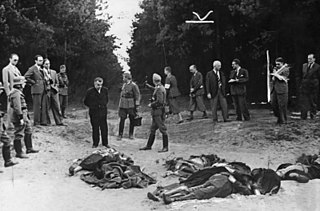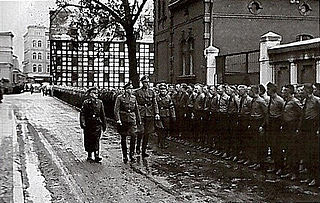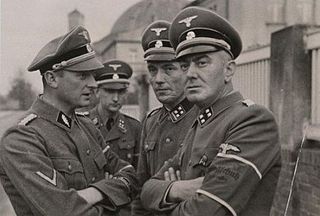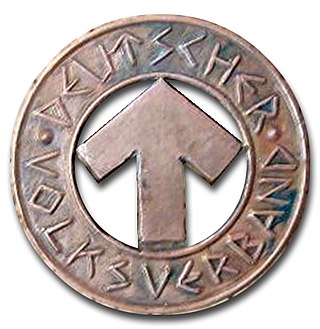History
The organization was established on September 8, 1934, in Bydgoszcz after solving the "German Union in Sejm and Senate". The organization included German minority organizations from northern Poland, such as the "Block of Unity" operating in Poznań, "Young German Block" from Grudziądz and the "German Central Election Commission" operating in Pomerania. Within 1,5 year, 150 branches were established, and by May 1934, the DV already had 16,474 members. At the turn of 1935/36, the number of members increased to 27,804. In the spring of 1939, the DV had about 35,000 members in the provinces of Poznań and Pomerania, which made it the second largest organization of the German minority in Poland. Organizationally, the DV, like other German organizations in pre-war Poland, was subject to the Hauptamt Volksdeutsche Mittelstelle, headed by Obergruppenführer Werner Lorenz. [1] DV published three newspapers, "Deutsche Rundschau in Polen" (Bydgoszcz), "Posener Tageblatt" (Poznań) and "Pommereller Tageblatt" (Tczew), which met primarily the goals of agitation. The German Union competed with another organization of the German minority in Poland - the Jungdeutsche Partei. On January 21, 1940, the German Union was dissolved. [2]

Szczecin is the capital and largest city of the West Pomeranian Voivodeship in northwestern Poland. Located near the Baltic Sea and the German border, it is a major seaport and Poland's seventh-largest city. As of December 2021, the population was 395,513.

In Nazi German terminology, Volksdeutsche were "people whose language and culture had German origins but who did not hold German citizenship". The term is the nominalised plural of volksdeutsch, with Volksdeutsche denoting a singular female, and Volksdeutscher, a singular male. The words Volk and völkisch conveyed the meanings of "folk".

Bloody Sunday was a sequence of violent events that took place in Bydgoszcz, a Polish city with a sizable German minority, between 3 and 4 September 1939, during the German invasion of Poland.

Bytów is a town in the Gdańsk Pomerania region of northern Poland with 16,730 inhabitants as of December 2021. It is the capital of Bytów County in the Pomeranian Voivodeship.

Złotów is a town in northwestern Poland, with a population of 18,303 inhabitants (2011). Today it is part of Greater Poland Voivodeship (province), previously being in Piła Voivodeship (1975–1998). Since 1999 Złotów has been the seat of Złotów County.

The History of Szczecin dates back to the 8th century. Throughout its history the city has been part of Poland, Denmark, Sweden and Germany. Since the Middle Ages, it is one of the largest and oldest cities in the historic region of Pomerania, and today, is it the largest city in northwestern Poland.
German Eastern Marches Society was a German radical, extremely nationalist xenophobic organization founded in 1894. Mainly among Poles, it was sometimes known acronymically as Hakata or H-K-T after its founders von Hansemann, Kennemann and von Tiedemann. Its main aims were the promotion of Germanization of Poles living in Prussia and destruction of Polish national identity in German eastern provinces. Contrary to many similar nationalist organizations created in that period, the Ostmarkenverein had relatively close ties with the government and local administration, which made it largely successful, even though it opposed both the policy of seeking some modo vivendi with the Poles pursued by Chancellor Theobald von Bethmann Hollweg and Leo von Caprivi's policies of relaxation of anti-Polish measures. While of limited significance and often overrated, the organization formed a notable part of German anti-democratic pluralist part of the political landscape of the Wilhelmine era.

Selbstschutz is the name given to different iterations of ethnic-German self-protection units formed both after the First World War and in the lead-up to the Second World War.

Werner Lorenz was an SS functionary during the Nazi era. He was head of the Volksdeutsche Mittelstelle (VOMI), an organization charged with resettling ethnic Germans in the "German Reich" from other parts of Europe, as well as colonising the occupied lands during World War II. After the war, Lorenz was sentenced to prison for crimes against humanity in 1948. He was released in 1954 and died in 1974.

The Province of Pomerania was a province of Prussia from 1815 to 1945. Pomerania was established as a province of the Kingdom of Prussia in 1815, an expansion of the older Brandenburg-Prussia province of Pomerania, and then became part of the German Empire in 1871. From 1918, Pomerania was a province of the Free State of Prussia until it was dissolved in 1945 following World War II, and its territory divided between Poland and Allied-occupied Germany. The city of Stettin was the provincial capital.

Valley of Death in Fordon, Bydgoszcz, northern Poland, is a site of Nazi German mass murder committed at the beginning of World War II and a mass grave of 1,200–1,400 Poles and Jews murdered in October and November 1939 by the local German Selbstschutz and the Gestapo. The murders were a part of Intelligenzaktion in Pomerania, a Nazi action aimed at the elimination of the Polish intelligentsia in Reichsgau Danzig-West Prussia, which included the former Pomeranian Voivodeship. It was part of a larger genocidal action that took place in all German occupied Poland, code-named Operation Tannenberg.

The Pomeranian Voivodeship or Pomorskie Voivodeship was an administrative unit of interwar Poland. It ceased to function in September 1939, following the German and Soviet invasion of Poland.

History of Pomerania between 1933 and 1945 covers the period of one decade of the long history of Pomerania, lasting from the Adolf Hitler's rise to power until the end of World War II in Europe. In 1933, the German Province of Pomerania like all of Germany came under control of the Nazi regime. During the following years, the Nazis led by Gauleiter Franz Schwede-Coburg manifested their power through the process known as Gleichschaltung and repressed their opponents. Meanwhile, the Pomeranian Voivodeship was part of the Second Polish Republic, led by Józef Piłsudski. With respect to Polish Pomerania, Nazi diplomacy – as part of their initial attempts to subordinate Poland into Anti-Comintern Pact – aimed at incorporation of the Free City of Danzig into the Third Reich and an extra-territorial transit route through Polish territory, which was rejected by the Polish government, that feared economic blackmail by Nazi Germany, and reduction to puppet status.

The Volksdeutscher Selbstschutz was an ethnic German self-protection militia, a paramilitary organization consisting of ethnic German (Volksdeutsche) mobilized from among the German minority in Poland. The Volksdeutscher Selbstschutz operated before, and during the opening stages of, World War II in the western half of Poland and were responsible for, and took part in, massacres of Poles, along with SS Einsatzgruppen. Selbstschutz counted circa 100,000 members, who formed greater part of German minority members "fit for action".

Deutscher Volksverband in Polen (DVV), or the German People's Union in Poland, was a Nazi German extreme right-wing political party founded in 1924 in central Poland by members of the ethnic German minority who did not wish to join the minority bloc in the Polish parliament Sejm. DVV was headed by August Utta, and financially supported by the Reich Ministry of Finance. Deutscher Volksverband was most active in the Łódź and Tomaszów area.

Sonderdienst were the Nazi German paramilitary formations created in semicolonial General Government during the occupation of Poland in World War II. They were based on similar SS formations called Volksdeutscher Selbstschutz operating in the Warthegau district of German-annexed western Poland in 1939.

Jungdeutsche Partei in Polen (JDP), or the Young German Party in Poland, was a Nazi German extreme right-wing political party founded in 1931 by members of the ethnic German minority residing in the Second Polish Republic.

The Pomeranian Arts House is a building of cultural and historical significance located at 20 Gdańska Street in Bydgoszcz, Poland. It has housed chronologically:
Piotr Triebler (1898–1952), was a Polish sculptor whose works are associated with Kuyavian-Pomeranian Voivodeship in general and with Bydgoszcz in particular.
Hermann Ernest Georg Dietz, generally called Hermann Dietz, (1861-1944) was a German physician, a member of the Bromberg city council, a senator of the Republic of Poland and a prominent social activist in the first half of the 20th century in Bromberg/Bydgoszcz.


















